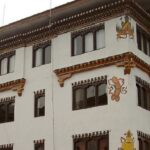The monuments in Maldives include old mosques, shrines, memorials, and government-built structures. Some were made centuries ago, while others were built recently to mark events like disasters or conflicts. These monuments are found in Malé and on other Malé islands of Maldives. Many of them are small and not part of tourist plans, but they are part of the country’s history. A few were made from coral stone and the rest were built using modern materials. Each one reflects something important from religion, leadership, remembrance, or change.
12 Popular Monuments In Maldives
This section covers the most significant monuments in Maldives, from coral mosques to national memorials.
1. Hukuru Miskiy, Malé

Photo: Zairon / Wikimedia Commons
One of the best places to visit in Malé, this 17th-century mosque sits quietly in the older part of Malé, built in 1658 under the rule of Sultan Ibrahim Iskandar I. It was made using coral stone, which locals shaped into blocks and arranged without mortar. Many of these stones still carry hand-chiselled Quranic text and decorative carvings. The woodwork inside is just as impressive, with beams cut from imported teak holding up a ceiling painted in deep reds and browns. There are panels with floral designs and lines of calligraphy that wrap around the walls. Outside, gravestones fill a courtyard in a different way. The tradition of using different shapes for men’s and women’s tombs continues here, with pointed tops for men and round ones for women. Despite being centuries old, Malé friday mosque remains a working mosque and prayers are still held daily.
Location: Medhuziyaarai Magu, Malé
Timings: 9 AM – 5 PM
Suggested Read: Things To Do In Male
2. Medhu Ziyaaraiy Shrine

Photo: Jan van der Wolf / Pexels / Image For Representation Only
Not far from the Grand Friday Mosque in Malé, there’s a quiet little spot called the Medhu Ziyaaraiy Shrine. The whitewashed building holds the tomb of Abu al-Barakat Yusuf al-Barbari, who came from North Africa and is remembered for introducing Islam to the Maldives around the 12th century. The structure is nothing grand, just a plain, square room with simple walls and a low roof. The tomb inside is raised slightly from the ground and left undisturbed. Islanders often stop by briefly, offering a prayer or standing in silence. It’s quiet, meaningful, and part of how the islands changed forever. This one tomb marks the beginning of a new faith that shaped the Maldives into what it is today.
Location: Shaheed Ali Hingun, Malé
Timings: 8 AM – 6 PM
3. Mulee’aage Palace, Malé

Photo: Zairon / Wikimedia Commons / Image For Representation Only
Just across from the Friday Mosque, Mulee’aage stands quietly behind its iron fence, shaded by palm trees. It was built in 1914 by Sultan Shamsuddeen III, who wanted it as a home for his son. The design is unusual for a palace with pastel walls, sloped tile roofing, and tall windows with wooden frames. It reflects both local craftsmanship and the influence of British architecture from the time. Though intended as a royal residence, the building was never used for that purpose. Years later, after the Maldives became a republic, it took on a different role as the presidential residence. It has also been used for government-related work. Visitors are not allowed inside, but you can still see the building from the road.
Location: Medhuziyaarai Magu, Malé
Timings: Not open for public visits
Suggested Read: Male Island
4. Islamic Centre & Grand Friday Mosque, Malé

Photo: Jolle / Wikimedia Commons / Image For Representation Only
The Islamic Centre is one of the most recognised buildings in Malé. Opened in 1984, it includes the Grand Friday Mosque, the largest mosque in the Maldives. Its golden dome can be seen from across the capital, standing above clean white walls and wide marble steps. The building was designed by Malaysian architects and built with help from several Islamic countries. The mosque can hold over 5,000 worshippers inside and the main prayer hall is spacious, quiet, and open, with simple chandeliers and carpets laid out across the floor. There are no statues or images, only calligraphy and geometric designs in keeping with Islamic tradition. The Centre also includes a library, conference hall, and administrative offices. Though modern in design, it plays a central role in religious life. Locals often attend Friday prayers here, and visitors can enter outside prayer times if dressed respectfully.
Location: Orchid Magu, Malé
Timings: 9 AM – 5 PM
5. National Museum & Sultan Park, Malé
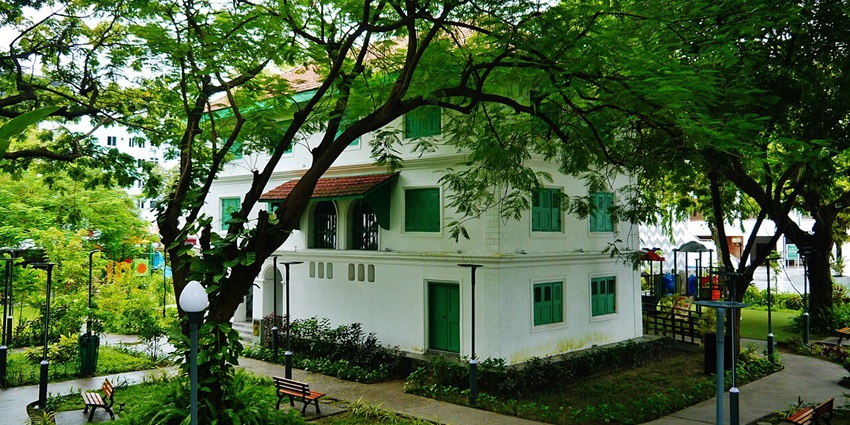
Photo: Zairon / Wikimedia Commons
Sultan Park in Malé holds more than just trees and shaded benches, it’s where the National Museum Maldives is located, housed in a preserved section of the former royal palace. The building combines a newer exterior with one of the last surviving palace wings from the 1600s. You’ll find coral carvings from the Buddhist period, traditional royal clothing, ceremonial swords, ancient Arabic scripts, and coins from different eras inside. Some exhibits date back to before Islam was introduced to the islands. There are also relics from the Islamic period, such as finely crafted woodwork and handwritten Qurans. The museum paints a fuller picture of Maldivian history of both Buddhist and Islamic roots. Locals sit here during lunch breaks or after prayer, while school children often visit on tours.
Location: Medhuziyaarai Magu, Malé
Timings: 10 AM – 4 PM
Suggested Read: National Museum Maldives
6. Kalhu Vakaru Mosque, Malé
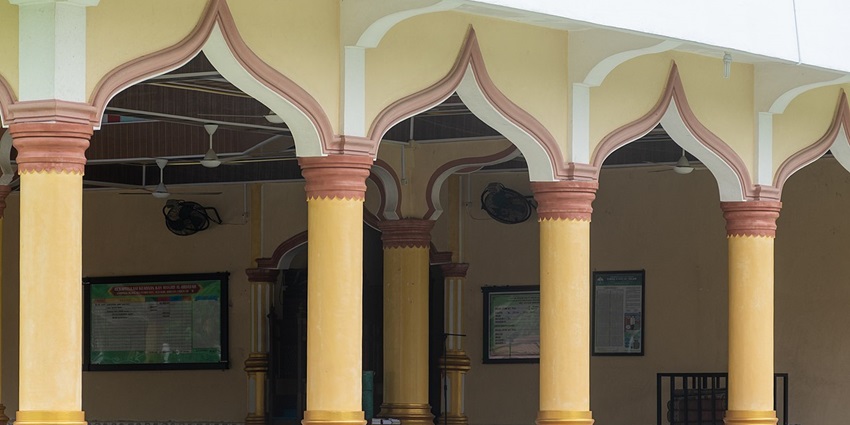
Photo: Rachmat04 / Wikimedia Commons / Image For Representation Only
One of the Maldives historical sites the Kalhu Vakaru Mosque was originally built in the late 1700s using coral stone and timber. It once stood in another part of Malé but was carefully dismantled and moved to Sultan Park to preserve it. Every piece, stone, beams, and panels was numbered and reassembled to keep it exactly as it was. The structure is small and square, with a sloping roof supported by thick teak beams. The wood was carved with floral and geometric patterns, and some panels still show Quranic calligraphy. Though simple in structure, the mosque reflects a time when local craftsmanship shaped every detail of a place of worship. Unlike other monuments in Maldives, this is a more tucked-away prayer house.
Location: Sultan Park, Malé
Timings: Viewable from outside during park hours
7. Utheemu Ganduvaru, Utheemu Palace
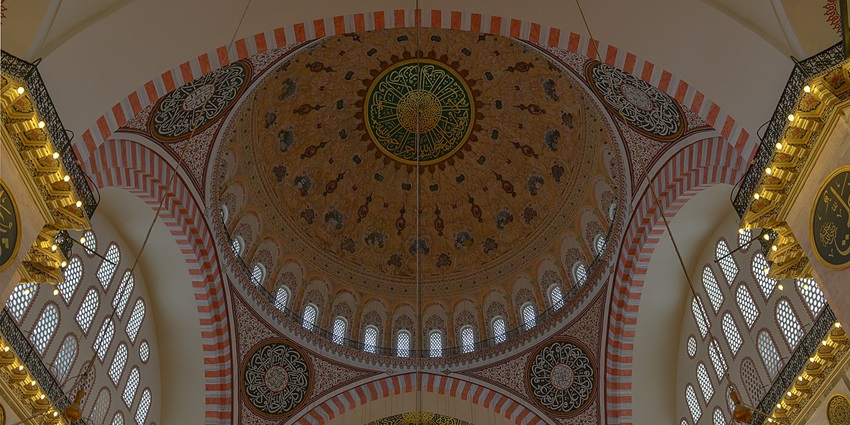
Photo: Arild Vågen / Wikimedia Commons / Image For Representation Only
On the northern island of Utheemu stands a quiet wooden house with a rich past. Utheemu Ganduvaru was the home of Sultan Mohamed Thakurufaanu, the national hero who led a rebellion against Portuguese rule in the 16th century. The building is made entirely of timber with thick walls and small, dark rooms that reflect traditional island architecture. It has been preserved carefully and its carved doors, sleeping quarters, and prayer room are still intact. There are no luxury furnishings here. Everything is functional, made by hand, and filled with stories. Locals often visit with pride, and visitors come to understand how a simple island home became the centre of a turning point in Maldivian history. It remains one of the country’s most respected heritage sites.
Location: Utheemu Island, Haa Alif Atoll
Timings: 9 AM – 5 PM
Suggested Read: Things To Do For Kids In Maldives
8. Tsunami Monument, Malé
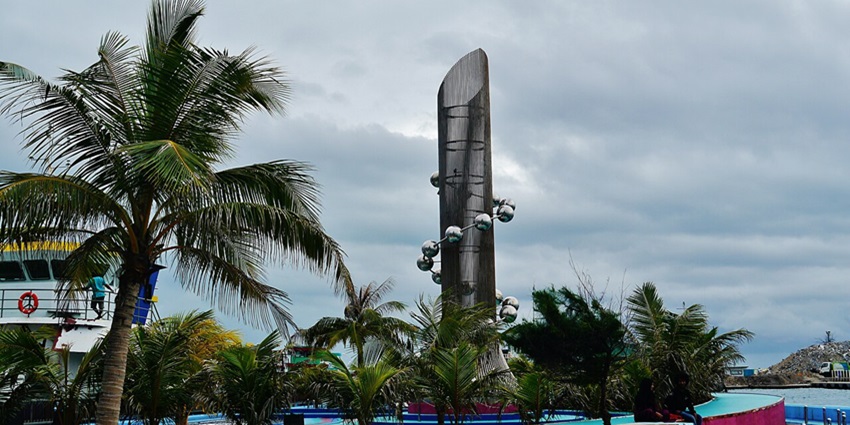
Photo: Zairon / Wikimedia Commons
The Tsunami Monument in Malé was built to remember the 82 Maldivians who died in the 2004 Indian Ocean tsunami. It is located near the coast of Boduthakurufaanu Magu, close to Thin Ruh Park. The monument includes 20 steel balls placed on rods and each ball represents one of the country’s atolls. A taller rod stands in the centre. Some rods have the names of victims engraved on them. The shape of the structure suggests waves rising from the sea and there is no wall or gate. Visitors stop by, especially on the tsunami anniversary, and some leave flowers. The space is simple and serves as a place for remembrance. The monument is one of the only permanent public memorials in the Maldives that marks a natural disaster.
Location: Boduthakurufaanu Magu, Malé
Timings: Always open
9. Victory Monument, Malé
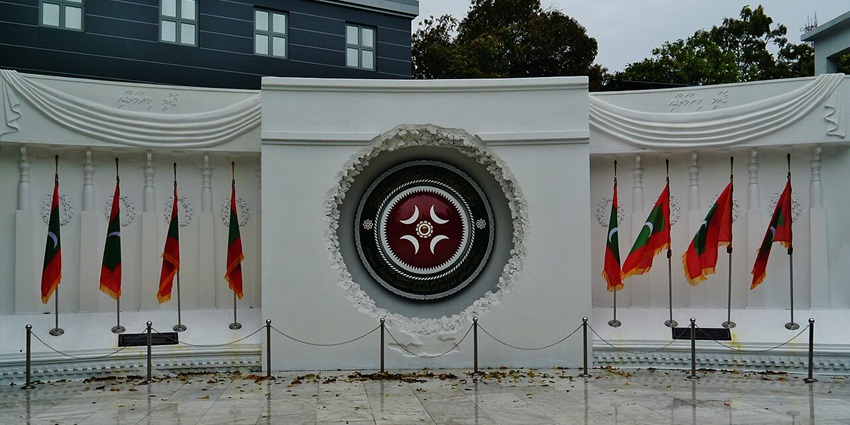
Photo: Zairon / Wikimedia Commons
The Victory Monument is located near the Ministry of Defence in central Malé. It was built to remember those who died during the armed attack on 3 November 1988. The attack was carried out by foreign mercenaries who entered the capital by sea. Maldivian soldiers and civilians were killed in the fighting. The monument includes a black pillar placed on a circular platform. Small plaques nearby name the people who lost their lives. The area around the monument has benches, a paved walkway, and flagpoles. It is maintained by the state and sits in an open space with no gates or entry fees. The site is not crowded, and most visitors are locals who come out of respect.
Location: Boduthakurufaanu Magu, near the Ministry of Defence, Malé
Timings: Open daily
Suggested Read: Explore Islands In Maldives Known For Crystal Waters, White Sands, And Relaxed Tropical Vibes
10. Sinamalé Bridge, Malé-Hulhulé-Hulhumalé
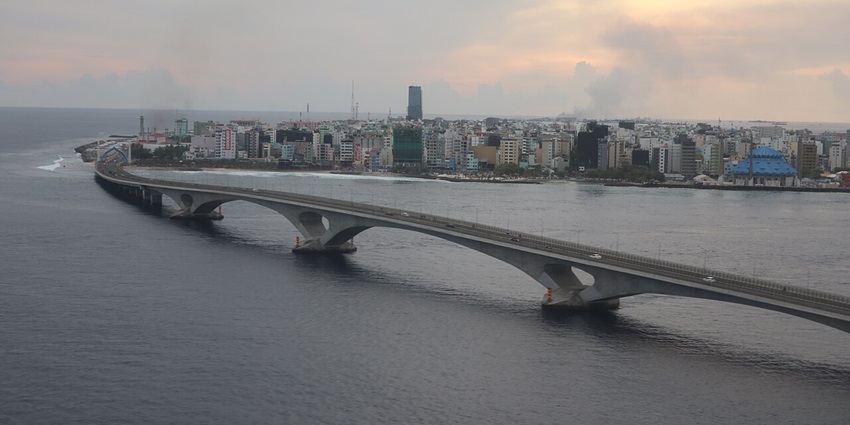
Photo: Panda 51 / Wikimedia Commons
The Sinamalé Bridge connects three islands, Malé, Hulhulé, and Hulhumalé. It opened in August 2018 and was built with funding from China. It is the first overwater road link between islands in the Maldives. The bridge is around 2.1 kilometres long and has three lanes, one for cars, one for motorcycles, and one for pedestrians. It connects Malé directly to Velana International Airport, which is on Hulhulé. People use the bridge daily to travel between the capital and nearby residential areas. The walkway on the side is used for walking, especially in the evening. The bridge is lit by street lamps and has barriers on both sides for safety, one of the beautiful places in Maldives for honeymoon. It is one of the most important infrastructure projects in the country, which changed how people move between the capital and the airport without using boats.
Location: Between Malé, Hulhulé, and Hulhumalé
Timings: Open at all times
11. Gadi Buru
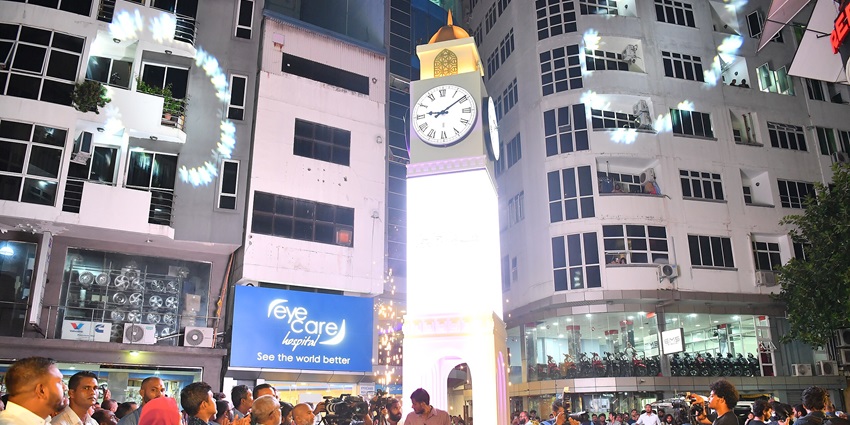
Photo: The President’s Office, Maldives / Wikimedia Commons
Gadi Buru, also called the Independence Memorial Clock Tower, is one of the striking Maldives monuments in Malé. First built in 1990 to celebrate the Silver Jubilee of Maldivian independence, it was demolished in 2017 and later rebuilt in 2023 with a modern design. The tower now stands as a reminder of the nation’s hard-won independence and resilience. Locals and visitors alike stop here to see this urban landmark, which blends historic importance with a renewed contemporary look.
Location: Malé City Centre, Maldives
Timings: 24*7
Suggested Read: Explore The Best Places To Visit In Maldives In April For A Peaceful Island Vacation
12. King Salman Mosque

Photo: LittleT889 / Wikimedia Commons
Opened in 2022, the King Salman Mosque is counted among the best monuments in Maldives. Located in Malé, it is the largest mosque in the country, accommodating up to 10,000 worshippers at once. Its five tall minarets symbolise the five pillars of Islam, and inside, it houses a library, classrooms, and an auditorium. Built with Saudi funding, it has quickly become one of the popular monuments in Maldives, admired not just for worship but also for its modern architectural splendour.
Location: Malé, Maldives
Timings: 24*7
The monuments in Maldives show more than just architecture. They tell stories about religion, history, and national events. Some honour leaders or heroes and others remember disasters or turning points in the country’s past. These places are not always large or well-known, but they are meaningful. Visiting them offers a different view of the Maldives, one that goes beyond beaches and resorts. For anyone interested in the country’s roots, plan your visit with TripXL and look into what people value, remember, and continue to protect.
Cover Photo: Godot13 / Wikimedia Commons / Image For Representation Only


 WhatsApp
WhatsApp
 Twitter
Twitter



